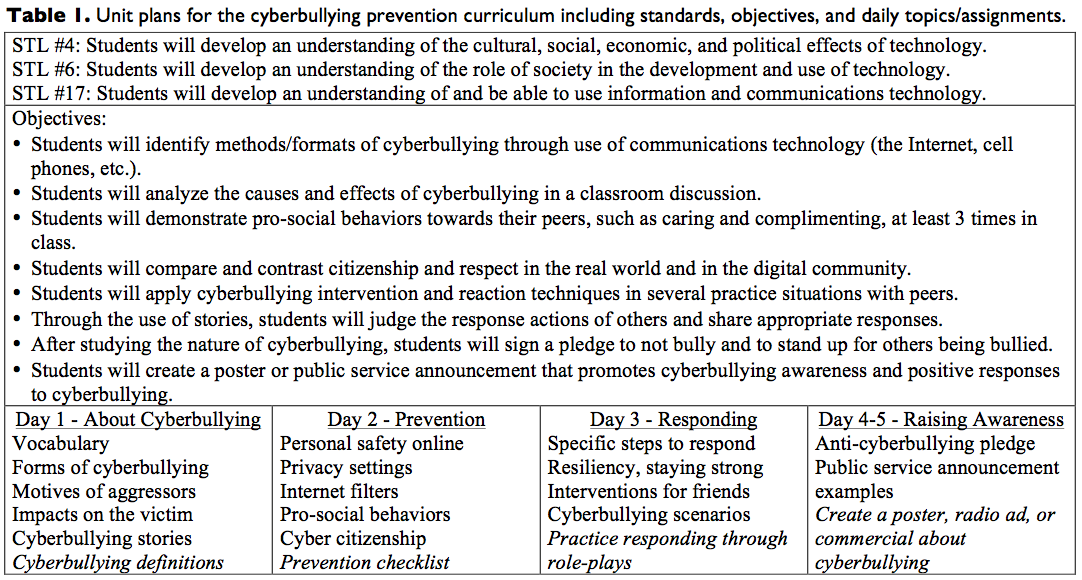Andrew Jackson and Dr. Geoff Wright, Department of Technology and Engineering Education
With the advancement of communication technology and the increasing influence it has in our lives, the prevalence of a new intimidation tactic, cyberbullying, is multiplying. Recent studies cite that between 25% and 46% of adolescents are victims of cyberbullying or online harassment (Li, 2006; Palfrey et al., 2010). At present there is limited access to a cyberbullying prevention curriculum for educators; cyberbullying prevention resources have not been synthesized into useable curriculum.
The purpose of this project is to promote the incorporation of cyberbullying prevention curriculum in Career and Technical Education courses by providing synthesized teaching resources for cyberbullying prevention. To validate the teaching curriculum, pre and post- assessments were used to analyze student response data before and after the unit. The outcomes of the project are a unit curriculum outline that focuses on cyberbullying and a data analysis of the inclusion of this curriculum in a classroom setting.
The foundation of the research project consisted of a literature review to gather present information about cyberbullying prevention. This curriculum draws from the resources of several organizations: the National Crime Prevention Council (ncpc.org), violencepreventionworks.org, the National Center for Missing and Exploited Children (netsmartz.org), cyberbullying.us, and commonsensemedia.org. After exploring the resources of these groups, the researcher organized the topics into a unit plan. First, national standards were identified through the International Technology and Engineering Educators Association that support cyberbullying curriculum in technology classrooms (2000). Next, based on information and resources provided by the organizations, objectives were defined to guide the lessons. In meeting the objectives and standards a suggested timeline and topical guide were created. The daily themes for the unit are general information about cyberbullying, cyberbullying prevention, responding to cyberbullying prevention, and raising awareness for cyberbullying. The standards, objectives, and daily topics are included in Table 1. Daily assignments are italicized.
In order to assess the effectiveness of the curriculum in reducing cyberbullying involvement, the unit was taught in a local middle school and data was collected from students providing parental consent. A pre and post-assessment were developed to quantify the knowledge of students as it relates to the content. These assessment scores were analyzed using a dependent means t-test to compare the difference between each individual’s score before and after the unit. The test found that student scores improved significantly after the unit: t(44) = 3.919, p < .001. This result suggests that the unit made a significant difference in student knowledge of cyberbullying related information. These scores also had a medium effect size (d =.58) indicating that there is moderate change between the means before the unit and after the unit. On the assessment, students also identified a greater number of areas online where cyberbullying might occur as well as pro-social behaviors, or positive attitudes that show caring about the welfare of others.
In addition to using the assessment, the Cyberbullying and Online Aggression Survey was used. The Aggression Survey asks questions about student involvement as victims or aggressors in cyberbullying (Patchin & Hinduja, 2009). Due to the anonymity of the survey, results before and after were treated as independent samples and compared using another t-test. The scores did not show significant change; however, there was minimal involvement in cyberbullying which is likely the reason for lack of change.
Although not each area of the study showed significant changes, the overall results of the study were positive. The results suggest that student participation in the curriculum positively affects student knowledge about cyberbullying and readiness to respond to it. The progress of this study has demonstrated some limitations that could be addressed: the quality and rigor of the pre and post-assessments could be improved; the scope of the study could also be increased which might reach a sample of students with greater initial involvement in cyberbullying.
This is an incipient area of research and this project brings to light the importance of making these new curricula available for easy incorporation. Hopefully the curriculum ideas developed in this research study, in connection with the positive changes suggested by the assessment tools, helps promote the inclusion of cyberbullying curriculums more fully in technology classrooms.
References
- International Technology Education Association., & Technology for All Americans Project. (2000). Standards for technological literacy: content for the study of technology. Reston, Va.: International Technology Education Association.
- Li, Q. (2006). Cyberbullying in Schools: A Research of Gender Differences. School Psychology International, 27(2), 157-170.
- Palfrey, J. G., Multi-State Working Group on Social Networking of State Attorneys General of the United States. Internet Safety Technical Task Force., Boyd, d., Sacco, D. T., & Harvard University. Berkman Center for Internet & Society. (2010). Enhancing child safety and online technologies: final report of the Internet Safety Technical Task Force to the Multi-State Working Group on Social Networking of State Attorneys General of the United States. Durham, N.C.: Carolina Academic Press.
- Patchin, J. W., & Hinduja, S. (2009). Cyberbullying and Online Aggression Survey, 79-81.

